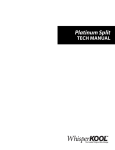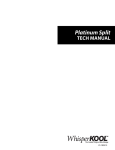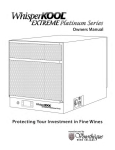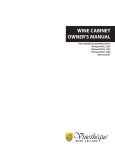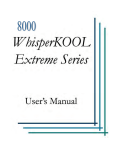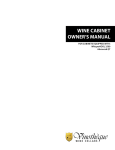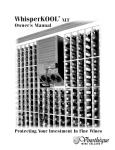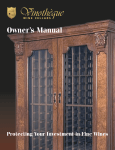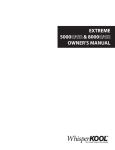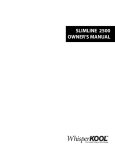Download WhisperKool 6000i System information
Transcript
The Coolest Thing in Wine Storage VERIFICATION AND OPERATIONAL DOCUMENTATION for Warranty Registration System Information Model Number: Serial Number: Condensing Unit: Evaporator Unit: Installer Information Company: Address: Technician Name (print): City: Certification ID Number: State: Zip: Certification Source (e.g. NATE): Company Phone: Technician Phone: Company Email: Technician Email: Note: For the equipment warranty to be valid certain installation piping and start up procedures are required. WhisperKOOL procedures are expected to be followed and completed by the installing contractor and/or certified HVAC/R service tech. The tech shall be required to be equipped with the proper tools of the trade including: refrigerant 134a, brazing equipment, dry Nitrogen, an accurate manifold gauge set (digital preferred), plus a four valve manifold set for evacuation, digital micron gauge, digital scale, deep vacuum pump, accurate digital thermometers and digital psychrometer. Without the proper equipment, a professional job cannot be accomplished. Evidence of the certified tech’s, NATE# or other certification is required. Certified service tech acknowledges compliance with the above by initialing the appropriate spaces below and filling blank spaces with data observed. IMPORTANT: DOCUMENT MUST BE COMPLETED AND RETURNED TO ACTIVATE WARRANTY www.whisperkool.com • 1-800-343-9463 Purpose for Checklist From experience we have learned that the knowledge, experience and competence of certified service technicians varies. This material has been prepared to be a technical guideline for the proper installation, plumbing, charging and start-up of a WhisperKOOL split system. Task Tech Initials All work has been accomplished in a workman like manner with emphasis on cleanliness and protection of the copper tubing from entry of dirt, moisture and other contaminants. The unit’s installation manual, piping diagrams and Copeland’s green “Installation Instructions For Condensing Units”, sections applying to air cooled condensing units have been read, understood and complied with. The evaporator unit has been unpacked and inspected for freight damage and all parts accounted for. The voltage supplied matches the rating outlined on the unit spec label. Installation of the evaporator unit. A a. Evaporator unit is installed level. B b. Suction line is properly insulated inside of evaporator. c. Evaporator is installed to a minimum of 6” and no further than 18” from ceiling. C d. Condensation drain line has been connected and tested for proper flow and leaks. D e. Unit controller has been connected and tested. E f. Bottle probe has been connected and placed in 3/4 full wine bottle. F The condensing unit has been unpacked, inspected for freight damage, set level and with proper clearances in accordance with the instructions, name plate power supplied, proper electric disconnect and fuse protection connected but not turned on and ready for piping connections. Installation of the condensing unit. A a. Condensing unit has a dedicated non-GFI 20 amp circuit. b. There is 3 ft. clearance in front and rear of the condensing unit. c. If installed outside, outdoor condensing unit housing is being used. When installing/routing the line sets both ends of each tube are capped to prevent material or debris from entering the tubing. www.whisperkool.com • 1-800-343-9463 B C Task Tech Initials Refrigerant Piping Procedures: Cleanliness is of the utmost importance. All horizontal suction piping shall be pitched toward the condensing unit 1/2” for every 10’ of pipe. During any brazing procedure, dry Nitrogen shall be purged through the fitting at a slow rate to prevent formation of highly abrasive Copper Oxide. Make sure there are no obstructions to the flow which would cause pressure build up and the brazed fitting to leak. After leak testing and confirming there are no refrigerant leaks, insulate suction line with 1/2” wall thickness Armaflex or equal type insulation. All seams have been sealed with Armaflex 520 Foam Insulation Adhesive or equivalent and have been wrapped with line set tape to prevent the intrusion of humidity. Evacuate the system with a vacuum pump to 200 microns or less measured with a digital micron gauge connected to the Schrader Type Access valve in the suction line. Procedures followed: Prior to connecting the piping, loosely connect refrigerant gauges to the service ports of the suction and liquid line service valves. Purge the charging hoses with dry Nitrogen, tighten hose connections, remove service valve caps, followed by turning service valve stem 1/2 turn clockwise to unseat the valve from its back seated position and opening the service port to the gauges. Keep the piping port sealed until ready to connect to the tubing. Procedures followed: It is required to use a 1/4” OD Copper tube liquid line. When making connections, keep the ends sealed until ready to fit the tube. First, connect the supplied refrigerant drier close to the liquid service valve (king valve) on the receiver. Downstream, connect the moisture indicating sight glass in an easily visible location. Run the tubing to the evaporator location and fit to the liquid line stub from the evaporator unit. Energize the evaporator unit and set the temperature controller to activate the liquid line solenoid valve. Uncap the suction pipe to prevent obstructing Nitrogen flow. Open the Nitrogen to allow a slow flow and braze the liquid line fitting. Shut off the Nitrogen and power until suction line is brazed. Procedures followed: Suction line tubing size selection is dependent on the capacity of the unit being installed, length of the suction line, and the length of vertical lift if any. Determine if the condensing unit is above the elevation of the fan coil unit and if so, the distance above in feet. In some cases, one size smaller tubing is required for the vertical length only. For the Mini split, with about 1650 BTUH nominal capacity, 3/8”OD tubing is required for up to 100’ equivalent length and is OK for a vertical rise. For the 4000 series with about 4700 BTUH nominal capacity, 1/2” OD tubing is required for up to 50’ equivalent length. 5/8” OD is required for line set lengths between 51’ and 100’. 1/2” OD is required for a vertical rise of 10’ or more. For the 7000 and 8000 series with about 6000 BTUH nominal capacity, 1/2” OD tubing is required for up 25’ equivalent length. For line set lengths 26’ to 100’, 5/8” OD tubing is required. 1/2” OD is required for a vertical rise more than 3’. In accordance with the piping diagrams (found in the Split Owners Manual), an inverted loop or trap is advised above the riser to prevent oil running back down the tube during the off cycle. Please fill the unit size, equivalent length and size of tubing installed. Unit __________________ Length ______________ Vertical rise ____________ Tube size ____________ Tube size ___________ www.whisperkool.com • 1-800-343-9463 Task Suction Piping Procedure: Keep tubing sealed while running to connection points. Fit suction tubing to evaporator outlet connection. It is recommended to fit a Schrader Type Access valve at the evaporator to allow for superheat checking and a micron gauge attachment. Fit suction tubing to condensing unit suction service valve port. If there are no fittings along the length of the suction tubing, slide the Aramaflex insulation over the tubing for the entire length of the tube or apply as convenient. Keep end of tube sealed during this procedure. If there are brazed fittings along the length of the tube, apply the insulation after leak testing. Energize the fan coil unit solenoid valve, open Nitrogen valve to bleed Nitrogen from liquid line service valve through liquid line and suction line. Loosen suction gauge hose to relieve pressure while brazing. Braze the connections and cool off quickly. Keep solenoid energized. Connect refrigerant cylinder; add a small amount of 134a to high and low sides, then connect the Nitrogen cylinder and start pressurization. On all series except the Mini series, this is a good time to check and verify the low ambient control setting and function. Remove one wire from the Johnson pressure control and connect an ohmmeter to its two terminals. With pressure below 100 psi, the meter should read open circuit. Slowly increase pressure to 170 psi at which pressure the controller should make and the meter read continuity. After leak testing, slowly reduce pressure to 100 psi and at that pressure the ohmmeter should read an open circuit, and at which pressure the condenser fan would stop. Continue pressure build up to 200 psi. Check to see if there is a noticeable pressure drop, if so look for and fix leak. With pressure at 200 psi, check for leaks with a refrigerant leak detector and/or soap bubbles. Confirm pressure holds at 200 psi for 30 minutes. If not check again for leaks and repair, perform another leak test. When it is confirmed there are no leaks, slowly reduce pressure to check low ambient control then bleed off the remaining pressure. Confirm that these procedures have been followed and there are no refrigerant leaks. Procedures followed: Evacuation: Connect evacuation type four valve gauge manifold to high and low pressure service valve ports on the condensing unit with the valve stems mid seated as when leak testing. Install service caps on valves and tighten. Energize the liquid line solenoid valve. Make sure there is fresh oil in the vacuum pump. Connect a micron gauge directly to the pump, blank off and start the pump to verify the pump is capable of a 200 micron vacuum and the gauge is capable of reading that vacuum. Next, connect the micron gauge to the access valve installed in the suction line at the evaporator, remove the Schrader valve depressors from the gauge hoses to reduce restriction and connect to the suction and liquid line service valve service ports on the condensing unit. Connect the pump to the 3/8” hose on the manifold set, start the pump and run until the micron gauge reads 200 microns. Confirm evacuation is complete and enter the micron gauge reading. Micron gauge reading _________ When 200 micron evacuation is achieved, break the vacuum with R 134a and add more to pressurize to a few psi positive pressure. Remove vacuum pump and micron gauge and install a spare low pressure gauge to the access valve at the evaporator. With the power off to the condensing unit, place refrigerant cylinder on a digital scale and admit liquid refrigerant to the system through the high pressure side, (through the liquid line service valve) until the refrigerant stops flowing or about three pounds have been added. Shut off refrigerant flow to system. Check thermostat setting and temperature of cellar or bottle that the probe is sensing. Set the controller low enough for continued running of 30 minutes or more. Turn on power to condensing unit. Compressor should start if suction pressure is above 6 psi. If system pumps down and compressor shuts off, set 5 minute time delay relay time to lowest setting to avoid waiting. Add refrigerant to low side, suction service valve port. When compressor starts, observe sight glass. If bubbles are present, slowly add more refrigerant, in vapor form to the low side. Suction and head pressures should increase as sight glass clears. Check superheat during charging process. If superheat drops to 4 or 5 degrees and sight glass still has bubbles, let run until wine cellar temperature drops and approaches 55 degrees. Procedures followed: www.whisperkool.com • 1-800-343-9463 Tech Initials Task Tech Initials Measure Superheat: If superheat is high and bubbles are present, add more refrigerant until clear. If superheat is low (around 4 - 6 degrees), and bubbles are present in the sight glass, check for liquid refrigerant entering the compressor as evidenced by cool crankcase, below 100 - 110 degrees and low discharge superheat. Adjust TXV setting in small increments to increase superheat and stop liquid to compressor. Check this before adding more refrigerant. If temperature of air entering the condenser is cold enough to cause the condenser fan to cycle, block about 60% of the coil to raise the head pressure and allow time for stabilization Reduce blockage if condensing temp is above 115 degrees. Retain blockage if necessary to maintain stability for performance tests listed below if air is cold, below 60 degrees entering the condenser With a clear sight glass, allow to run for a while until the cellar cools off then measure and record data listed below. Procedures followed: CHECK BEFORE LEAVING YOUR JOB SITE Task Evaporator panel has been reinstalled and secured with supplied screws. Controller is displaying correct temperature. The controller is not displaying an alarm. Suction line is completely insulated, from solenoid valve to compressor. Sight glass has no visible bubbles. Ambient air temperature around condensing unit is not getting excessively hotter. Both king valves have been back seated. Nuts have been installed back on the king service ports. Protective nuts have been installed back on the king valve over the stem. COMPLETE DATA RECORDINGS ON NEXT PAGE www.whisperkool.com • 1-800-343-9463 Tech Initials DATA RECORDINGS Temp of air entering evaporator coil: Wb (Wet Bulb): Temp of air leaving unit (Supply Air Db): Db (Dry Bulb): Temperature difference Db (Delta): Temp of air entering the condensing unit (irrelevant if condenser coil is blocked): Is coil blocked to raise condensing temp? YES / NO Head pressure PSI: Converted to temp: Temp of liquid line at the service valve: Suction pressure PSI: Converted to temp: Temp of suction line at the outlet of the evaporator: Superheat calculation: Is suction pressure hunting, fluctuating? YES / NO Is suction pressure steady? YES / NO Is compressor crankcase cool, below 110 deg? YES / NO Compressor Running? YES / NO Voltage to compressor: Amp draw at time of above performance conditions: Confirm operation of low ambient control. If below 60 deg air entering condenser. Remove artificial Blockage and allow control to operate. Record the pressure at which the condenser fan motor is activated, also record the pressure at which the condenser fan motor is deactivated. For Models 4000, 7000, and 8000 the cut in should be set at 170 psi, and cut out at 100 psi, adjust Johnson control if necessary. Cut in Pressure: Cut out Pressure: Condenser fan runs vibration free and normal? YES / NO Condensing unit runs and sounds normal? YES / NO Evaporator section runs and sounds normal? YES / NO Water leaks from evaporator section? YES / NO Temperature on controller is set at 55 degrees or customer’s desired temperature setting? YES / NO Time delay relay located in condensing unit control panel (not on Mini Split) confirmed to be set at five minutes? Warranty material filled out? YES / NO Comments: Mail to: Fax to: Scan and email to: WhisperKOOL 209.466.4606 [email protected] ATTN: Warranty Registration 1738 E. Alpine Avenue Stockton, CA 95205-2505 USA OR OR www.whisperkool.com • 1-800-343-9463 YES / NO






